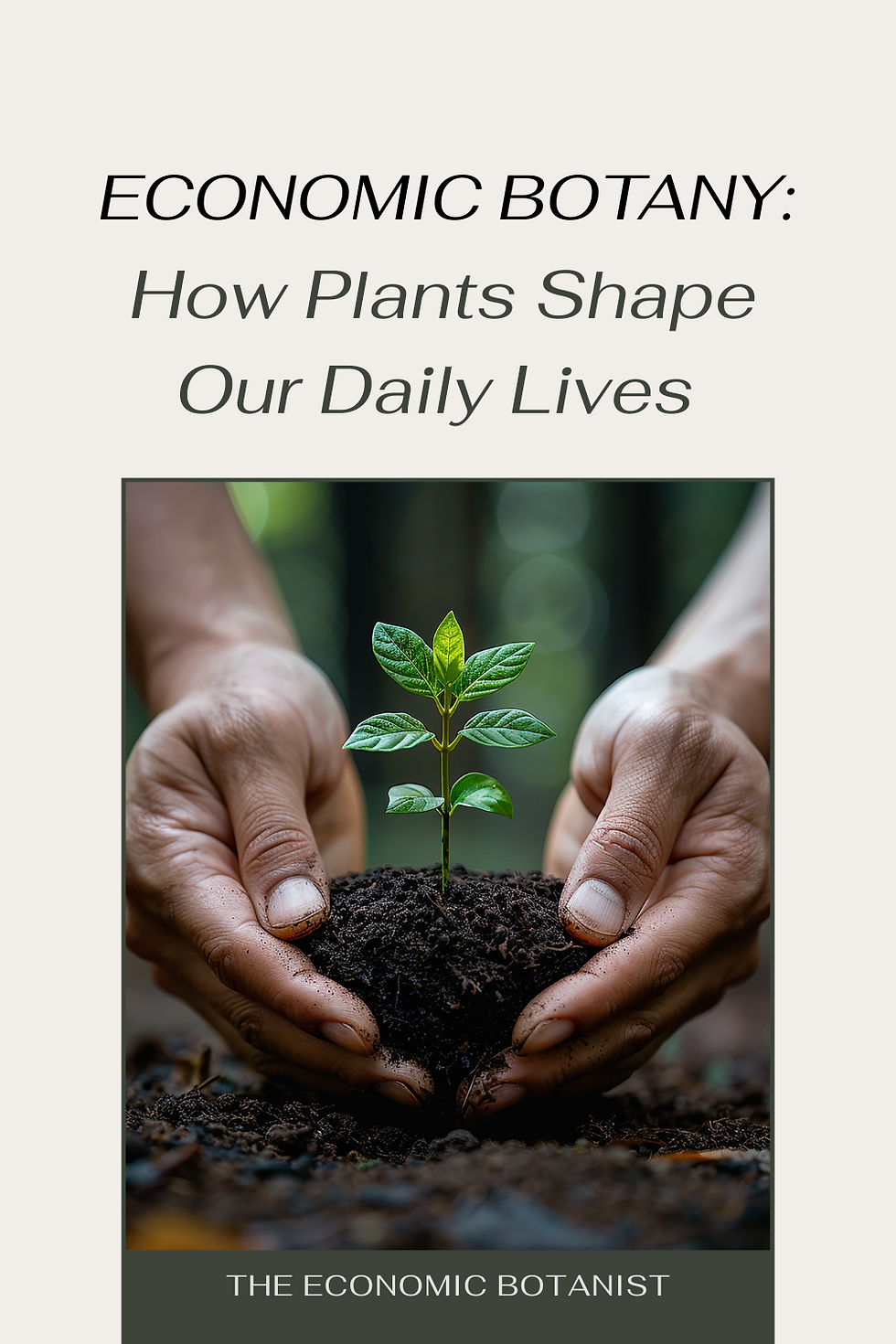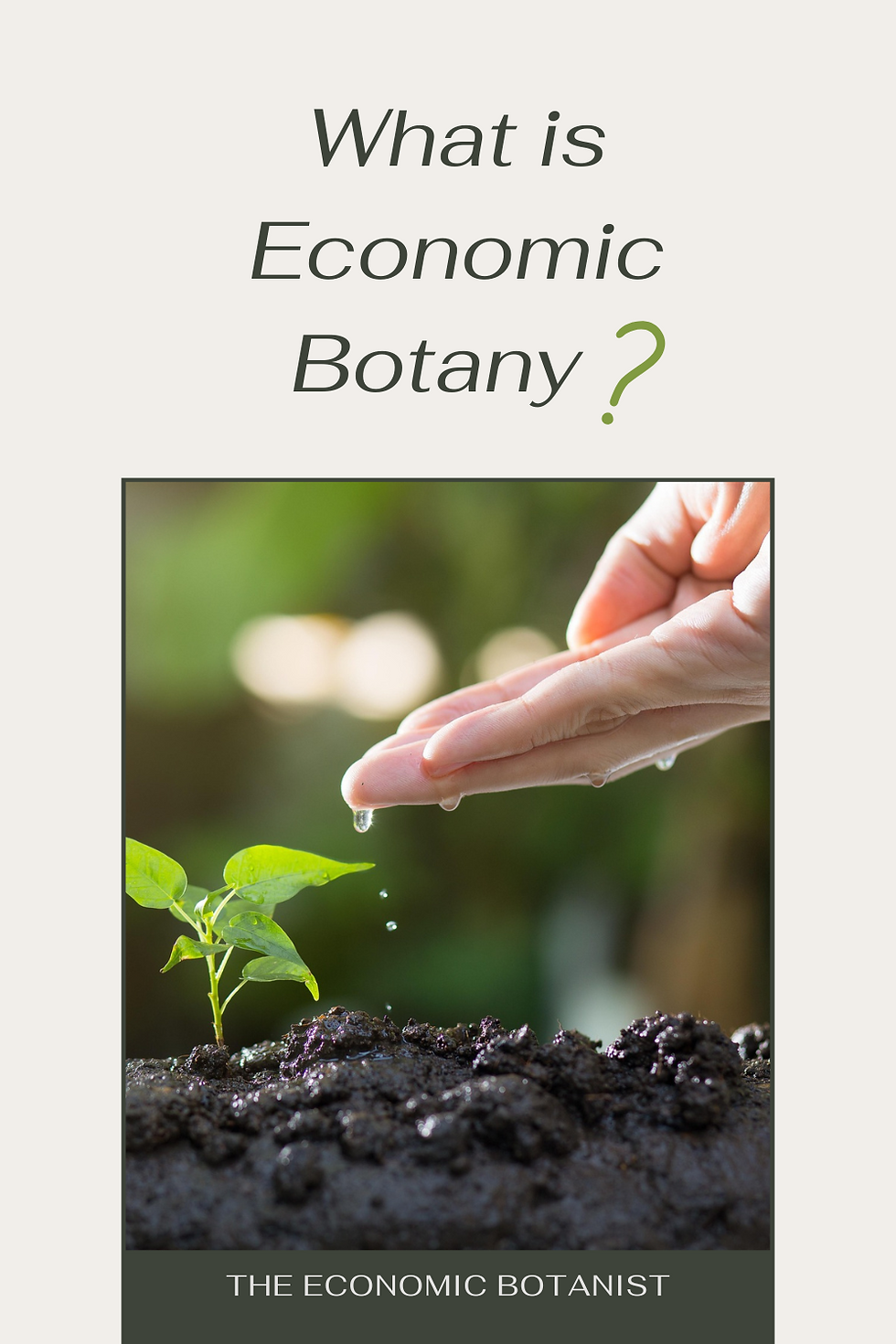Discover the Role of Economic Botany in Our World
- The Economic Botanist

- Jul 6
- 7 min read
This article is about the incredible world of economic botany and its role in connecting plants and human economies.

“We believe plants aren’t just part of the environment—they’re part of the human solution.” - The Economic Botanist
Have you ever looked at your plate of food, your cotton T-shirt, or even the medicine in your cabinet and thought, “Wow—plants made this possible”? Whether we realize it or not, plants are deeply woven into almost every part of our daily lives. They feed us, clothe us, heal us, and even help power our homes and cars.
That’s where economic botany comes in. This fascinating field explores how humans use plants for food, medicine, clothing, and so much more—and how we can do it all in a way that protects our planet for the long haul.
In this article, we’ll dig into the world of economic botany. You’ll learn what it is, why it matters, and how it's helping us build a more sustainable, plant-powered future.

Understanding Economic Botany
Let’s start with the basics. Economic botany is the study of how people use plants—practically and culturally. It covers everything from how Indigenous communities have used plants for thousands of years to how modern science is unlocking plant-based solutions for today’s problems.
It’s not just about agriculture (though that’s a big part). Economic botany spans food, medicine, clothing, construction, cosmetics, fuel, and even spiritual practices. It’s about understanding how plant resources can meet human needs—while also learning how to use those resources responsibly.
At its heart, economic botany asks questions like:
How can we grow food more sustainably?
What plants can help treat disease or improve health?
Are there eco-friendly alternatives to plastics, textiles, or fuels?
How have different cultures used plants over time?
This field helps us rethink how we live with and depend on the plant world—and how we can keep that relationship going in the future.
The Importance of Economic Botany
You might be wondering: why does this field matter so much? Well, here are a few big reasons.
1. Food Security in a Growing World
By 2050, the global population is expected to hit nearly 10 billion. That’s a lot of mouths to feed. Economic botanists play a major role in studying crop varieties, improving yields, and helping farmers adapt to changing climates.
They look at both high-tech approaches—like genetic modification and precision agriculture—and traditional farming methods that have stood the test of time. The goal? Resilient crops that can grow in tougher conditions while using fewer resources like water or pesticides.
This research is especially important as extreme weather, soil loss, and biodiversity decline threaten food production around the globe.
2. Medicinal Plants That Save Lives
It’s easy to forget, but a huge number of modern medicines started with plants. Aspirin, morphine, quinine, and Taxol (a chemotherapy drug from the Pacific yew tree) all came from nature.
Economic botany and pharmacology work hand in hand to explore the healing power of plants. Scientists are still discovering new compounds from tropical rainforests, mountain herbs, and desert shrubs—many with potential to treat diseases like cancer, malaria, and more.
And let’s not forget traditional medicine. Many communities have been using plant-based remedies for centuries. Understanding and validating these practices opens doors to affordable, culturally relevant healthcare options around the world.
3. A Path Toward Renewable Resources
With the world trying to move away from fossil fuels and plastic waste, plants are stepping up as part of the solution. Think:
Biofuels made from corn, sugarcane, or algae
Bioplastics made from plant starches
Natural fibers that replace synthetic fabrics
These plant-based alternatives aren’t perfect, but they’re making real progress. The more we understand about which plants can do what, the more we can shift toward a sustainable bioeconomy.
Fun Fact: The oldest known plant used by humans for fiber is hemp, with evidence of its use going back over 10,000 years. It’s making a comeback today as a sustainable alternative to synthetic fabrics and plastics. |

What is Eco Botany?
Now, let’s take a quick detour into eco botany—a closely related field that focuses more on the relationship between plants and their environments.
While economic botany asks, “How can we use this plant?”, eco botany asks, “How does this plant live, survive, and interact with its ecosystem?”
Eco Botany in Action
Eco botany helps us understand:
How plants adapt to their environment
What roles plants play in their ecosystems
How to conserve endangered species and native flora
How humans can restore damaged ecosystems using native plant knowledge
As climate change disrupts natural habitats, this kind of research becomes even more essential. By studying plant biodiversity and ecosystem resilience, eco botany gives us tools to protect the living web we all depend on.
Applications of Economic Botany
Okay, let’s get into the practical side of things. Here’s where economic botany shows up in your everyday life—and in industries you might not expect.
🌾 Agriculture and Food Systems
This is one of the most obvious areas. Economic botanists work on:
Crop improvement (better yields, more nutrients, pest resistance)
Soil management (like using cover crops to boost soil health)
Climate-resilient farming
Preserving heirloom and Indigenous plant varieties
They also draw insights from traditional farming knowledge, which often includes time-tested sustainable methods.
💊 Medicine and Herbal Remedies
Plants are the original pharmacy. Some economic botanists focus on discovering new medicinal compounds. Others validate traditional herbal treatments to understand how they work—and when they’re safe and effective.
There’s also growing interest in how functional foods (like turmeric, ginger, and garlic) may support wellness and prevent disease.
👕 Textiles and Sustainable Fashion
Plants like cotton, hemp, and flax have been used for centuries to make fabric. Today, designers and scientists are teaming up to explore more sustainable, plant-based materials.
For example:
Bamboo is being processed into soft fabrics
Pineapple leaves are being turned into leather alternatives
Algae is used for biodegradable threads and dyes
These innovations could reduce the environmental toll of fast fashion.
💄 Cosmetics and Skincare
Take a peek at your lotion, shampoo, or serum—you’ll probably find ingredients like aloe vera, shea butter, chamomile, or tea tree oil. All plant-derived.
Companies are increasingly tapping into plant-based skincare because it’s often gentler, more sustainable, and packed with beneficial compounds. Economic botany helps identify new ingredients and ensures they’re harvested responsibly.
🍽️ The Rise of Plant-Based Foods
With more people exploring plant-based diets, economic botany is central to creating tasty, nutritious meat and dairy alternatives.
From soy and pea protein to jackfruit and chickpeas, plants are helping reinvent everything from burgers to cheese. Botanists help identify crops that are high in protein, sustainable to grow, and versatile in the kitchen.

Economic Botany and Sustainability
It’s no surprise that economic botany has a big role to play in building a more sustainable future. So, how can you get involved in small but meaningful ways?
Support Local and Diverse Agriculture
Buying from local farmers helps:
Reduce your food’s carbon footprint
Preserve local plant varieties
Keep farming knowledge alive in your community
Look for farmers' markets or join a CSA (Community Supported Agriculture) program.
Choose Sustainable Plant-Based Products
From bamboo toothbrushes to organic cotton T-shirts, there are more plant-based options than ever. Supporting eco-conscious brands encourages more innovation in the field.
Grow Your Own
Even a small herb garden connects you to the plants you eat. You don’t need a big yard—just a sunny windowsill or balcony.
Gardening helps you appreciate plant life and encourages biodiversity right in your own space.
Get Involved in Conservation
Whether it’s volunteering at a native plant nursery, donating to botanical gardens, or just learning about local flora, supporting conservation matters.
Economic botany depends on protecting plant diversity. Once a species is gone, we lose the potential benefits it might have offered—medicinal, nutritional, or ecological.
The Future of Economic Botany
Looking ahead, the future of economic botany is full of potential. As the world faces massive challenges—climate change, food insecurity, public health threats—plants could be at the heart of many solutions.
Here are some promising directions the field is heading:
Precision farming that uses AI and plant science to improve yields with fewer resources
Climate-smart crops designed to survive heat, drought, and floods
Urban agriculture and vertical farming to grow food in cities
New plant-based materials that replace plastic and reduce waste
Ethnobotanical studies that protect Indigenous knowledge and biodiversity
But all this innovation needs one key ingredient: awareness. The more people understand the value of plants—and how deeply they impact our lives—the more support there will be for sustainable research and policies.
The Bottom Line
Economic botany isn’t just an academic field—it’s a lens that helps us see the living world more clearly. It connects science, culture, and everyday life. It shows us how plants shape our history and future.
And perhaps most importantly, it reminds us that plants are more than background scenery. They’re powerful, essential partners in the story of human survival.
So the next time you sip herbal tea, slip into a cotton shirt, or eat a slice of bread—remember the plants that made it possible. And maybe, just maybe, think about how you can help protect and support the incredible plant world we all depend on.
********************
While you mentioned earlier that you don’t typically use a call to action at the end of your blog posts, here’s a light, non-salesy one that still fits your friendly professor tone. You can include it or leave it off!
Want to keep learning about the power of plants? Follow along for more insights into how botany, sustainability, and everyday life all connect—because the more we understand, the better we grow.
Science ReadingEconomic botany: Past and future: This article traces the historical development of economic botany, from its roots in herbalism and its expansion during the European Age of Exploration, to its more formal establishment in the United States through key publications and institutions in the 20th century. It highlights major agricultural milestones over the past 10,000 years and emphasizes the urgent need for another major breakthrough—possibly through genetic engineering—to meet global food demands by the year 2000. Access this article here Ethnobotany and Ethnopharmacology in the Americas: This special issue review explores how Indigenous communities in the Americas use plants for food, medicine, and culture. It also discusses ethical practices, intellectual property, and culturally respectful research methods. Access the paper here |



Comments